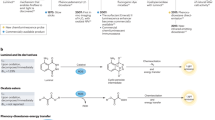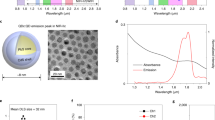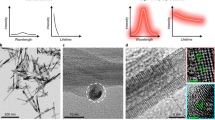Abstract
Imaging techniques are a vital part of clinical diagnostics, biomedical research and nanotechnology. Optical molecular imaging makes use of relatively harmless, low-energy light and technically straightforward instrumentation. Self-illuminating, chemiluminescent systems are particularly attractive because they have inherently high signal contrast due to the lack of background emission. Currently, chemiluminescence imaging involves short-lived molecular species that are not stored but are instead generated in situ, and they typically emit visible light, which does not penetrate far through heterogeneous biological media. Here, we describe a new paradigm for optical molecular imaging using squaraine rotaxane endoperoxides, interlocked fluorescent and chemiluminescent dye molecules that have a squaraine chromophore encapsulated inside a macrocycle endoperoxide. Squaraine rotaxane endoperoxides can be stored indefinitely at temperatures below −20 °C, but upon warming to body temperature they undergo a unimolecular chemical reaction and emit near-infrared light that can pass through a living mouse.
This is a preview of subscription content, access via your institution
Access options
Subscribe to this journal
Receive 12 print issues and online access
$259.00 per year
only $21.58 per issue
Buy this article
- Purchase on Springer Link
- Instant access to full article PDF
Prices may be subject to local taxes which are calculated during checkout




Similar content being viewed by others
References
Mettler, F. A. & Guiberteau, M. J. Essentials of Nuclear Medicine Imaging 5th edn (Saunders, 2005).
Mancini, J. G. & Ferrandino, M. N. The impact of new methods of imaging on radiation dosage delivered to patients. Curr. Opin. Urol. 20, 163–168 (2010).
Sharkey, R. M. & Goldenberg, D. M. Novel radioimmunopharmaceuticals for cancer imaging and therapy. Curr. Opin. Invest. Drugs 9, 1302–1316 (2008).
Roda, A., ed. Chemiluminescence and Bioluminescence: Past, Present and Future (Royal Society of Chemistry, 2010).
Su, Y., Chen, H., Wang, Z. & Lv, Y. Recent advances in chemiluminescence. Appl. Spectrosc. Rev. 42, 139–176 (2007).
Prescher, J. A. & Contag, C. H. Guided by the light: visualizing biomolecular processes in living animals with bioluminescence. Curr. Opin. Chem. Biol. 14, 80–89 (2010).
Roda, A., Guardigli, M., Michelini, E. & Mirasoli, M. Bioluminescence in analytical chemistry and in vivo imaging. Trends Anal. Chem. 28, 307–322 (2009).
Gassensmith, J. J., Baumes, J. M. & Smith, B. D. Discovery and early development of squaraine rotaxanes. Chem. Commun. 6329–6338 (2009).
Adam, W., Kazakov, D. V. & Kazakov, V. P. Singlet-oxygen chemiluminescence in peroxide reactions. Chem. Rev. 105, 3371–3387 (2005).
Stoddart, J. F. The chemistry of the mechanical bond. Chem. Soc. Rev. 38, 1802–1820 (2009).
Kay, E. R., Leigh, D. A. & Zerbetto, F. Synthetic molecular motors and mechanical machines. Angew. Chem. Int. Ed. 46, 72–191 (2007).
Gassensmith, J. J. et al. Synthesis and photophysical investigation of squaraine rotaxanes by ‘clicked capping’. Org. Lett. 10, 3343–3346 (2008).
Arunkumar, E., Sudeep, P. K., Kamat, P. V., Noll, B. C. & Smith, B. D. Singlet oxygen generation using iodinated squaraine and squaraine-rotaxane dyes. New J. Chem. 31, 677–683 (2007).
Salice, P. et al. Photophysics of squaraine dyes: role of charge-transfer in singlet oxygen production and removal. J. Phys. Chem. A 114, 2518–2525 (2010).
Gassensmith, J. J., Baumes, J. M., Eberhard, J. & Smith, B. D. Cycloaddition to an anthracene derived macrocyclic receptor with supramolecular control of regioselectivity. Chem. Commun. 2517–2519 (2009).
Aubry, J. M., Pierlot, C., Rigaudy, J. & Schmidt, R. Reversible binding of oxygen to aromatic compounds. Acc. Chem. Res. 36, 668–675 (2003).
Bloodworth, A. J. & Eggelte, H. J. in Singlet Oxygen (ed. Frimer, A. A.) Vol. 2, 93–203 (CRC Press, 1985).
Matsumoto, M., Yamada, M. & Watanabe, N. Reversible 1,4-cycloaddition of singlet oxygen to N-substituted 2-pyridones: 1,4-endoperoxide as a versatile chemical source of singlet oxygen. Chem. Commun. 483–485 (2005).
Fu, Y., Krasnovsky, A. A. Jr. & Foote, C. S. Singlet oxygen dimol-sensitized luminescence from thermally generated singlet oxygen. J. Am. Chem. Soc. 115, 10282–10285 (1993).
Ishii, H., Tsukino, K., Sekine, M. & Nakata, M. Singlet oxygen-sensitized delayed emissions from hydrogen peroxide/gallic acid/potassium ferricyanide systems containing organic solvents. Chem. Phys. Lett. 474, 285–289 (2009).
Murphy, S. T., Kondo, K. & Foote, C. S. Singlet-oxygen-sensitized delayed fluorescence: direct detection of triplet phthalocyanine as an intermediate. J. Am. Chem. Soc. 121, 3751–3755 (1999).
Descalzo, A. B. et al. Phenanthrene-fused boron-dipyrromethanes as bright long-wavelength fluorophores. Org. Lett. 10, 1581–1584 (2008).
So, M.-K., Xu, C., Loening, A. M., Gambir, S. S. & Rao, J. Self-illuminating quantum dot conjugates for in vivo imaging. Nature Biotechnol. 24, 339–343 (2006).
Frangioni, J. V. The problem is background, not signal. Mol. Imaging 8, 303–304 (2009).
Branchini, B. R. et al. Red-emitting luciferases for bioluminescence reporter and imaging applications. Anal. Biochem. 396, 290–297 (2010).
le Masne de Chermont, Q. et al. Nanoprobes with near-infrared persistent luminescence for in vivo imaging. Proc. Natl Acad. Sci. USA 104, 9266–9271 (2007).
Ma, N., Marshall, A. F. & Rao, J. Near-infrared light emitting luciferase via biomineralization. J. Am. Chem. Soc. 132, 6884–6885 (2010).
Troy, T., Jekic-McCullen, D., Sambucetti, L. & Rice, B. Quantitative comparison of the sensitivity of detection of fluorescent and bioluminescent reporters in animal models. Mol. Imaging 3, 9–23 (2004).
Tuchin, V. V. Tissue Optics 2nd edn (SPIE Press, 2007).
Dysart, J. S., Singh, G. & Patterson, M. S. Calculation of singlet oxygen dose from photosensitizer fluorescence and photobleaching during mTHPC photodynamic therapy of MLL cells. Photochem. Photobiol. 81, 196–205 (2005).
Hatz, S., Poulsen, L. & Ogilby, P. R. Time-resolved singlet oxygen phosphorescence measurements from photosensitized experiments in single cells: effects of oxygen diffusion and oxygen concentration. Photochem. Photobiol. 81, 1284–1290 (2008).
Pellieux, C., Dewilde, A., Pierlot, C. & Aubry, J.-M. Bactericidal and virucidal activities of singlet oxygen generated by thermolysis of naphthalene endoperoxides. Method. Enzymol. 319, 197–207 (2000).
Otsu, K. et al. Impaired activation of caspase cascade during cell death induced by newly synthesized singlet oxygen generator, 1-buthylnaphthalene-4-propionate endoperoxide. Cell Biol. Int. 32, 1380–1387 (2008).
Linet, M. S., Kim, K. P. & Rajaraman, P. Children's exposure to diagnostic medical radiation and cancer risk: epidemiologic and dosimetric considerations. Pediatr. Radiol. 39(Supp l), S4–S26 (2009)
Agawa, H., Nakazono, M., Nanbu, S. & Zaitsu, K. Chemiluminescence change of polyphenol dendrimers with different core molecules. Org. Lett. 10, 5171–5174 (2008).
Lee, C. C., Mackay, J. A., Fréchet, J. M. J. & Szoka, F. C. Designing dendrimers for biological applications. Nature Biotechnol. 23, 1517–1526 (2005).
Xiao, S., Fu, N., Peckham, K. & Smith, B. D. Efficient synthesis of fluorescent squaraine rotaxane dendrimers. Org. Lett. 12, 140–143 (2010).
Chatterjee, D. K., Fong, L. S. & Zhang, Y. Nanoparticles in photodynamimc therapy: an emerging paradigm. Adv. Drug Deliver. Rev. 60, 1627–1637 (2008).
Tallury, P., Payton, K. & Swadeshmukul, S. Silica-based multimodal/multifunctional nanoparticles for bioimaging and biosensing applications. Nanomedicine 3, 579–592 (2008).
Borisov, S. M. & Klimant, I. Luminescent nanobeads for optical sensing and imaging of dissolved oxygen. Microchim. Acta 164, 7–15 (2009).
Acknowledgements
The authors are grateful to the National Science Foundation (grant no. CHE 0748761 to B.D.S.) and the University of Notre Dame Integrated Imaging Facility for financial support.
Author information
Authors and Affiliations
Contributions
B.D.S. conceived this project and J.M.B. helped design the experiments. J.J.G., J.-J.L., W.J.C., A.G.W., W.M.L., J.G. and M.K. contributed to the experimental work and data analysis. B.D.S. and J.M.B. wrote the paper, and all co-authors contributed comments.
Corresponding author
Ethics declarations
Competing interests
The authors declare no competing financial interests.
Supplementary information
Supplementary information
Supplementary information (PDF 2138 kb)
Rights and permissions
About this article
Cite this article
Baumes, J., Gassensmith, J., Giblin, J. et al. Storable, thermally activated, near-infrared chemiluminescent dyes and dye-stained microparticles for optical imaging. Nature Chem 2, 1025–1030 (2010). https://doi.org/10.1038/nchem.871
Received:
Accepted:
Published:
Issue Date:
DOI: https://doi.org/10.1038/nchem.871
This article is cited by
-
Near-infrared luminescence high-contrast in vivo biomedical imaging
Nature Reviews Bioengineering (2023)
-
Tuning the Solid Phase Fluorescence Emission from Long Wavelength Visible to Near-Infrared in Oxazol-5-One Derivatives: Structure–Property Relationship, Theoretical and Experimental Studies
Journal of Fluorescence (2023)
-
Synthesis and photophysical investigations of pyridine-pyrazolate bound boron(III) diaryl complexes
Scientific Reports (2022)
-
Turn-on chemiluminescence probes and dual-amplification of signal for detection of amyloid beta species in vivo
Nature Communications (2020)
-
Bioluminescence emissions from the Indian winter species of firefly Diaphanes sp.
Journal of Biosciences (2020)



